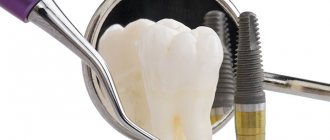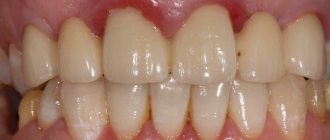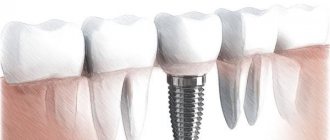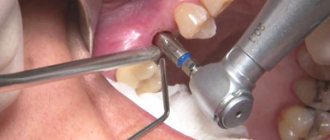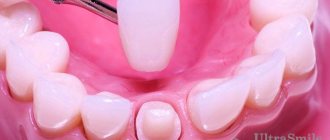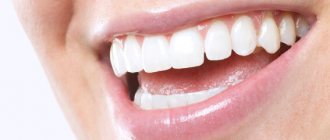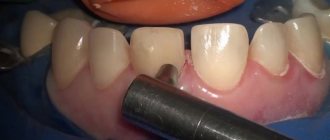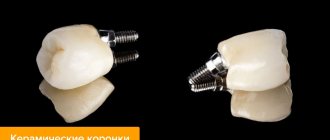Pros of ceramics
Engineers and chemists of large concerns for the production of dental materials (mostly German) are very hardworking and purposeful people. This is not a common stamp - I was convinced of this from my own experience, watching the evolution of ceramic crowns from Ivoclar Vivadent for 15 years. This is not an advertisement - this name means little to the average person, and dentists do not trust advertising. Over the years, the company has come a long way from really fragile crowns in the 2000s (the instructions said so - only for front teeth, with a bunch of contraindications) to the modern material e.Max (Imax, emphasis on the letter I), which in most cases regions is crowding out the former grandee - zirconium dioxide.
Let's list what makes Emax so remarkable:
- Strength. Allows you to make not only crowns, but also bridges. Not only for front teeth, but for any teeth. There is enough strength to spare.
- A huge selection of colors, transparency options , the possibility of individualization either by simple painting or by applying additional layers of ceramics (this is the finest work on the verge of craft and art, in some cases up to 15 layers of ceramics are used, achieving incredible naturalness).
- Possibility of manufacturing individual implant abutments. The abutment is the outer part of the implant; the crown rests on it. There are two options for their use - standard titanium abutments manufactured at the factory (there is no time for aesthetics here, the strength or complexity of the design is important) or individual abutments. If you make such an abutment from Imax material, the crown on the implant (by the way, it can also be Imax) will be more aesthetically pleasing.
- Emax has brought digital technology directly to the dental chair. Now the doctor can make crowns on his own and in one visit . The aesthetics and strength are the same, the accuracy is higher - the human factor is reduced to a minimum. This technology is called CEREC (Cerek, emphasis on the first syllable), in conjunction with modern ceramic materials, it is incredibly convenient for both the doctor and the patient.
- The crown is bonded to the tooth (dentists call this bonding) by creating a chemical bond between the ceramic, adhesive luting cement and the tooth tissue. This connection is absolutely sealed and durable.
What to make a tooth crown from so that it lasts as long as possible
Does the material used to make a crown affect the longevity of a tooth? Theoretically, of course, yes, the material can affect the service life of the dental crown. Let's find out why.
The first factor in service life is the thickness of the dental crown.
Let's consider the case if the usual classic metal ceramics are installed, under which it is necessary to depulp the tooth. In most cases, due to the fact that the metal layer (the thickness of the metal frame) can be at least 0.3-0.4 mm, the ceramic layer is 0.8 mm, then in the most “unaesthetic”, but most gentle for the patient, scenario, The thickness of the dental crown will be 1.1 mm and, accordingly, the tooth will have less tissue left. It is necessary to draw your attention to the fact that the tooth is pulpless and, of course, this is not very good for it, since the tooth will need to be ground down more actively for a crown:
And this is ideal; in fact, the wall thickness is even greater, and the ceramic layer can be at least 0.8 mm.
The second factor in the service life of a crown is the quality of the material.
The quality of ceramics also implies, in most cases, its cost. Many patients take risks when trying to find ceramics at a low price. Ceramics are different from ceramics. You need to clearly understand that chipping of ceramics can occur if it is not of sufficient quality.
Ceramic chips
cannot be repaired in the oral cavity, it is necessary to remove the crown from the tooth and make a new one. But, of course, each time removing a crown and making a new one is unlikely to have a positive effect on both the patient’s mood and the condition of his tooth. However, “pulling” the crown back and forth because you once decided to save money is not entirely correct, you will agree. Poor-quality ceramics will not bring much happiness to the tooth.
At the same time, modern ceramics - those that, so to speak, have increased strength and can be used even without frames, for example, E-max ceramics, with a minimum thickness, have a strength almost comparable to conventional metal-ceramics. Accordingly, the prosthetic tooth retains more of its tissues. In this case, the metal-free crown is fixed with special cements, from which it is almost impossible to remove this crown. In essence, an all-ceramic crown is its own, new restored tooth enamel, but ceramic.
CONCLUSION:
Of course, with such strength of ceramics and its minimal thickness, the tooth’s own tissues are preserved to a greater extent, so we can say that in this case the material affects durability in 100% of cases.
Now let's talk about the next important factor
, affecting the durability of the crown.
Will the crown sit firmly on your tooth or will it have to be removed. So this is the human factor
.
Advantages and disadvantages of gold crowns
Let's consider the main advantages :
- Such dentures do not have an abrasive effect on other teeth, thereby preventing their wear.
- Gold itself is beneficial for teeth, the whole body, and the oral cavity, improving its microflora.
- Gold structures are inert to saliva and food composition.
- Dentures do not cause allergies and are completely safe for humans. They will last longer than products made from other metals.
- Teeth are better preserved under crowns; they cope well with the chewing process.
- The structures themselves, made of gold, cannot break or splinter.
Minuses:
- Due to the softness of gold, crowns wear off.
- Making and installing gold structures is expensive.
- They ruin the aesthetic appearance if you replace the front teeth with prosthetics.
Features of crowns on implants
During implantation, the entire tooth is made anew: both the part that replaces the root and the visible part. The types of crowns for implanted teeth are as follows:
- ceramic;
- zirconium.
The abutment for ceramic crowns is often made of zirconium dioxide so that dark metal does not show through the ceramic. If a chewing tooth is implanted, the crown can be made of zirconium dioxide, and the abutment can be made of metal. However, this design is also suitable for the smile area, if the patient is not very capricious or is somewhat strapped for finances. Dental crowns on implants can be chosen not only by aesthetics, but also by cost. And since the price of dental crowns varies greatly, you can choose the option that will be quite affordable for you. It is not necessary to install dental crowns made of metal-free ceramics! It will be easier to determine which dental crowns are best if you know what your budget will be. Therefore, you should try to make a preliminary calculation together with your doctor.
How to extend the life of crowns?
Warranty period and service life are not the same thing. A warranty is needed to ensure that the work was done correctly. During this period, the clinic undertakes to replace the structure free of charge in case of breakdown.
But a high-quality crown will last longer than the 2-5 year warranty period. Optimal: 10 years or more. It's like with a computer: it has a 1-year warranty, but you use it for much more. And all because you treat him correctly. In this case we are talking about service life.
What can a patient do to make the crown last a long time?
Before installation
Materials. When choosing a clinic for dental prosthetics, pay attention to the materials of the crowns. You can see them in the price list, in the estimate after a consultation, or check by phone. Dental ceramics brands are usually not well-known, but you can read about them on the Internet. Brands that are not mentioned anywhere or the clinic’s refusal to name the manufacturer should raise red flags.
Doctor. When choosing a doctor, patients often look at examples of work. But from the photographs you can see the skills of a specialist in aesthetic dentistry. But for a long service life of the crown, it’s better to look at what topics the doctor has improved his qualifications on. The words “occlusion” or “load” in the titles of courses and seminars are a good sign.
View. The average service life of metal-ceramic, zirconium and ceramic crowns depends more on care than on type. Modern cements allow the crown to last almost a lifetime, as long as the health of the tooth and careful handling allow it. However, when planning treatment, be sure to listen to your doctor's opinion. The most expensive and considered reliable option is not always suitable for a particular patient.
Immediately after installation
Make sure that the teeth fit together comfortably with the crown and that nothing is in the way. It is often difficult to understand at an appointment whether the new design is comfortable. The patient sat for an hour with his mouth open, and his jaw was numb from immobility. What to do? Take a break until tomorrow. After resting, starting to talk and chew, you will feel if something is wrong.
Don't hesitate and don't delay. Getting used to the crown takes a couple of hours, and if the next day you are still uncomfortable, make an appointment with your orthopedist. The doctor will see you as soon as possible.
Lifetime
10 or more years. The main thing is to properly care for the restoration.
We take care of the crown
The material of modern crowns is not inferior in strength to natural enamel. But the list of harmful, traumatic factors remains.
Do not crack nuts with your teeth, bite threads, open bottles, or untie knots. It is not recommended to hold nails, screws, etc. in your mouth like a carpenter. If you play dangerous sports such as hockey or boxing, be sure to wear a mouthguard.
Remember: anything that can chip a tooth can chip a restoration.
Protecting the tooth under the crown
The crown protects against tooth decay, but a small part of the tissue under the gum remains vulnerable to bacteria. Carefully observe oral hygiene: regularly and properly brush your teeth, use floss or a special brush, as well as an irrigator. Don't let an infection form under your gum.
Well-groomed gums are protected from periodontal disease, so teeth are stable and firmly held in place.
Let's take care of our neighbors
It is important that the remaining teeth are also in order. If the neighboring one is destroyed, it needs to be built up or strengthened with a crown, otherwise it will no longer participate in chewing. The load will be distributed unevenly. Then other teeth, including the one with an expensive crown, may chip or shift.
If an adjacent tooth is lost, it should be restored with an implant or bridge. If this is not done, the teeth on the sides will begin to shift towards the failure. And the opposing tooth on the other jaw will become mobile in the absence of load.
The situation will become even more complicated if several units are lost. The risk of crown breakage or chipping of veneering ceramics will increase many times over.
We protect the entire dental system
It's not just about healthy eating and preventative procedures. It is important to contact your dentist in a timely manner if any problems arise in the oral cavity, even those not related to a specific crown.
For example, bruxism often causes a short lifespan for crowns. If your orthopedic structures break down after 3-4 years, be sure to tell your doctor about it. Bruxism, spasmodic clenching of the masticatory muscles, can be successfully treated both before and after prosthetics.
Orthopedic dentist V.A. Chesnokov: I recommend coming in for an examination once a year, even after the warranty period has expired. The orthopedist will check the load distribution using a carbon paper. The fact is that over the years, teeth naturally wear down and decrease in height. But the crown is harder than enamel, it does not wear off. And over time, it becomes the highest point on the jaw; it bears the entire load when chewing. This could cause the crown to break. Trouble can be easily avoided by simple checking and polishing.
How much will a dental crown cost for one tooth?
Potential patients are wondering what the prices are for dental crowns. This information can be obtained from the website of a specific clinic. But you also need to take into account the cost of preparing the tooth. The doctor is also interested in the patient knowing which dental crowns are best and which one to choose, which is why he will be ready to calculate the cost of all stages of treatment.
If the patient is brought to the clinic for the restoration of dental crowns, then it is also advisable for him to consult with the doctor who will be involved in the treatment. It happens that a dental crown falls out after many years, and the clinic where it was placed no longer exists, and it is unknown where to look for a doctor. This does not mean that you will have to make the crown again. It is quite possible that the doctor will find a way to use the old crown if it has not yet served its useful life. Then there is an opportunity to save on the crown itself, but you need to know how much it will cost to restore or reinstall the crown.
Any dental work costs some money. If you independently calculate everything according to the price list, you may accidentally miss some mandatory operation and not include it in the total cost. Therefore, it is better to consult with a doctor, and if this is not possible, then try to make a preliminary calculation with the registrar.
Caring for dental crowns after prosthetics
How long the installed structure will last depends not only on the quality of dental services, but also on proper care. After installing a crown, it is important to follow these recommendations:
- You will be able to eat 2 hours after installation of the prosthesis, and drink immediately;
- For the first few days, it is better to chew solid food on the opposite side; over time, the load can be increased, but you should no longer chew nuts at all;
- after installing prostheses made of plastic or metal-ceramics, it is better to avoid taking coloring foods: coffee, beets, red wine, etc.;
- after each meal you need to rinse your mouth, using an irrigator to rinse the interdental spaces; It is better not to use dental floss, as they can damage the denture;
- brush your teeth twice a day with a soft toothbrush and toothpaste without abrasive particles; President pastes with an RDA abrasiveness rating of less than 50 units are suitable. (Preggy for pregnant and nursing mothers and Junior).
Crown care products
Myths about crowns, or why are patients afraid of having crowns installed?
I often see fear and disappointment on the faces of patients when the word “crown” is mentioned. And I am sure that this is not unfounded. Almost every patient of mine has either a personal bad experience, indirectly or directly related to “crowns,” or his friends or relatives have such an experience. Let's try to understand the reasons for this unsuccessful experience using the example of questions and arguments that patients use to operate.
Myth one: “Teeth decay and rot under crowns”
Yes, this happens, and patients come to me with similar problems. The reasons may be different, but they are all quite understandable.
Reason one. Teeth that were severely damaged even before prosthetics. Unfortunately, crowns are sometimes offered to a patient in cases where, according to modern treatment protocols, it is time to remove a decayed tooth. Hence the problems - if a tooth is critically damaged by life, then the crown is only the final chord, which often does not last long. If a tooth is destroyed to the level of the gum (or under the gum), and there is no way to improve this situation, it is better to replace such a tooth with an implant while there is enough bone tissue around.
Reason two. Poor hygiene. If this is the cause of the destruction of healthy teeth, then no crown will save a weakened tooth from the effects of microorganisms.
Reason three. Neglect by the doctor of such an important clinical stage as the manufacture of intermediate crowns. People also call them “temporary”. For modern doctors, the stage of making “temporary” crowns is inextricably linked with the making of permanent ones. If you neglect it, problems may arise.
Reason four. Poor quality crowns that do not fit well to the tooth. When there is a large gap between the tooth and the crown, this will not lead to anything good. Plaque accumulates in the cracks, an unpleasant odor appears in these areas, and the gums begin to become inflamed.
Here is one example of a tooth being removed due to a huge gap formed by the edge of an old metal crown.
If desired, one could stick a finger into this gap. Now compare the fit of the old metal crown with this photo:
The crown-tooth boundary, even with high magnification, is visible only by the color transition. The microscopic gap is securely closed with fixing cement, like a sealant. This is the kind of fit that any modern crown should strive for.
Myth two: “The tooth needs to be ground down heavily for a crown.”
This is not entirely true. Currently, in modern dentistry it is customary to preserve tooth tissue as much as possible, as this improves the prognosis of restoration. Using magnification - an operating microscope and binoculars - the doctor has very good control over how much tooth tissue he removed during treatment. As a rule, for a modern design it is enough to remove 0.6-0.9 millimeters of tissue, depending on the clinical situation, and an adequate doctor always strives for these values.
In this photo there were 2 teeth side by side with different approaches to treatment for crowns. On the right is a tooth cut down excessively (the thickness of the removed tissue is about 2 mm), on the left is a tooth processed using magnification (the thickness of the removed tissue is 0.4-0.6 mm). Modern materials (metal-free ceramics) and magnification tools allow dentists to treat teeth 3-4 times more carefully. And this significantly affects their service life.
Myth three: “If anything happens, after the crown the only thing is removal.”
Let's look at the previous paragraph. If the boundary between the edge of the crown and the tooth is above the gum, if the grinding was done carefully under magnification, then re-prosthetizing such a tooth even after a long time is not a problem. If the tooth is destroyed even before prosthetics, then there is really nothing to hope for.
Myth four: “Teeth under crowns must be depulped (the nerve removed) and pins placed.”
This is an inveterate myth, which, unfortunately, is still reinforced by many dentists. I can only say that with the use of modern equipment, cooling, adequate temporary prosthetics and careful hands, it is possible to work on vital - “living” - teeth without any problems. But often it is not necessary to cover such teeth with a full crown - it is enough to make an inlay.
These four myths are often the most important arguments of patients “against” dental restoration with crowns. What happens when patients choose a “filling” instead of a crown, arguing that “if it falls out, I’ll put a new one”? A few photos will answer best:
And the reason for such fractures is that the load on the tooth is very serious, and many, including some dentists, do not take this into account. The crown allows you to distribute the chewing load more evenly and safely over the remaining part of the tooth, without leading to chipping of the walls. Whether it is worth risking a tooth and preferring a large composite filling to a durable, properly made ceramic crown, everyone decides for themselves.
And now I would like to give an example of work according to modern indications. The patient underwent endodontic treatment of the root canals of tooth 4.6 due to irreversible pulpitis, then a decision was made to make an indirect all-ceramic restoration (crown).
The “core” of the tooth was restored and it was prepared for a full crown:
View of the finished restoration in the oral cavity after a few weeks:
PS So, is the word “crown” really a death sentence for a tooth? In my opinion - no! And with my article I tried to prove this with examples. The procedure for making a crown in modern dentistry is a high-tech event aimed at preserving the tooth and its further long-term functioning. The use of water cooling during preparation and a rubber dam make the procedure quite comfortable for the patient. The doctor's use of magnification allows maximum control over the preparation process. And such a novelty as digital impressions saves the patient from what is perhaps the most unpleasant procedure in prosthetics. In the right hands, an indirect restoration (crown or inlay) can help protect the tooth from fracture. If they are wrong, they lead to problems and disappointments, which give rise to many myths. So, dear patients, choose your doctor carefully! Good luck to everyone!
Author of the article: Pavel Pola
Authors of photos of clinical cases: Pavel Pola and Kirill Kostin
What materials are used to make modern crowns?
Today, most materials for crowns are the color of natural tooth enamel, and metal crowns can still be installed only in the depths of the mouth, since they are not visible there, but this makes prosthetics generally cheaper. One more condition must be met: the patient is not allergic to metal. For allergy sufferers, crowns without metal impurities are recommended:
- plastic;
- ceramic.
A new material is also used - zirconium dioxide, which is not a metal in its pure form and takes root well in the oral cavity. If the patient is not short of money, he can order zirconium dioxide crowns, which are excellent in appearance and strength.
Metal dental crowns
- They are made either from gold or from a special medical alloy. In the latter case, it is a silver-colored metal. It is believed that gold is best suited to the human body; it does not oxidize and does not form dangerous compounds upon contact with saliva or food. However, gold looks beautiful as jewelry, and not when it is used to make a tooth, which by nature is destined to have a completely different color.
Metal ceramics
- In terms of strength, it is worth choosing metal-ceramic dental crowns, especially since they practically do not differ in color from natural tooth enamel. However, the presence of a metal-ceramic crown in the dentition can be revealed by its insufficient degree of transparency. The tooth turns out to be similar to a real one, but at the same time somehow “lifeless” in appearance. This is due to the fact that the inside of this crown is metal and the outside is ceramic. Opaque metal can be slightly visible through the ceramics, becoming an absolute barrier to light rays.
Solid ceramic
- These crowns are more fragile, but they look almost like natural tooth enamel. The biocompatibility of a crown made from solid ceramics is the highest. Doctors prefer to place such dental crowns on the front teeth, because the aesthetic factor plays a key role here. However, the patient is not recommended to bite off even an apple with a tooth with such a crown, not to mention nuts or other solid foods. Doctors advise keeping a knife with you that can be used to divide food into small pieces.
Zirconium dioxide
- A new and inexpensive material that has almost all the aesthetic properties of ceramics and the strength characteristics of metal ceramics is zirconium dioxide. This type of prosthesis is also called zirconium crowns. They are equally good to use both on chewing teeth and on the front teeth - incisors and canines. So far, only one drawback of zirconium dioxide crowns has been identified - high cost.
Plastic crowns
- Today it is possible to create plastic that would be similar to real tooth enamel and at the same time have good biological compatibility with the human body. Typically, a plastic dental crown is a temporary option. They do not last long, are stained by food and can crack. This type of crown is widely used during implantation - during the healing of the implant. Also, this “cap” can be used to cover a prepared tooth while a permanent crown is being made from a more expensive material.
Metal-plastic dental crowns
- The idea of a metal-plastic dental crown is the same as that of a metal-ceramic one. Only this type is cheaper. If the goal is to use such crowns on temporary structures or for a period of long-term treatment of a prepared tooth, then they are completely justified. But it would hardly be worth using such a product for more than three years. In addition to the disadvantages that metal-ceramic and plastic crowns have, metal-plastic structures have another flaw - the plastic lags behind the metal base. But as temporary dental crowns, they are a more durable option than just plastic.
How to care for gold crowns
If gold crowns are installed in your mouth, they do not require special care. Simply brushing your teeth in the morning and evening with a brush using toothpaste and using dental floss is enough to clean the spaces between the teeth.
It is advisable to avoid eating too hard foods. You need to forget the cracking of seeds, nuts, biting pieces of ice, as well as the habit of biting your nails, clenching your teeth, and grinding them.
If you are concerned about plaque on gold crowns, you can clean them with a special abrasive toothpaste that contains a substance that removes the top layer. It contains bacteria that cause the noble metal to darken.
Sometimes there are unexpected situations when crowns have to be removed. This can be caused by toothache, poor quality of the denture, or swelling of the gums. Removal will require a visit to the dentist for diagnostics. He will assess the condition of your gums and teeth and offer options to eliminate the problem.
